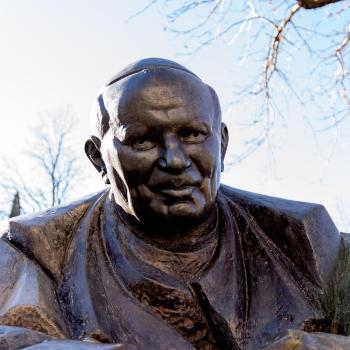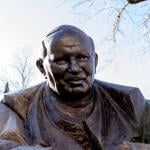JOHN ASKS:
When did circumcision start and how was God involved? How did its use evolve to today’s practice?
THE RELIGION GUY ANSWERS:
In the Jewish faith, ritual circumcision of males (bris) to remove the foreskin of the penis has been a requirement ever since God designated it as a “sign of the covenant” with Abraham (Genesis 17:10-14). So God has been “involved” for some 4,000 years now.
Anthropologists tell us that circumcision was practiced long before Abraham, across the globe from pharaonic Egypt to aboriginal Australia. It was often a tribal “rite of passage” at puberty, and not the Bible’s sign of commitment to God performed on eight-day-old newborns. The “why” of circumcision prior to biblical times is uncertain. Macmillan’s “Encyclopedia of Religion” says contemporary experts dismiss the theories that it originated to mark captives, attract women, enhance sexual pleasure, aid hygiene, test bravery, or symbolize submission to elders or the cutting of bonds with mothers.
Jewish surgery and ceremonial are commonly the work of a specialist known as a mohel. The operation is traditionally required for adult converts as well as infants born in the faith. Though liberal Reform Judaism dropped that mandate in 1893, some of its rabbis continue the tradition. Note that any male born of a Jewish mother is deemed a Jew, even if he is not circumcised.
Jesus, as the son of devout Jews, was circumcised in infancy (Luke 2:21). But decades later Christianity’s first policy council made the Jewish regulation optional for Gentile converts to the new faith (Acts of the Apostles, chapter 15). As the missionary Paul hoped, this fostered rapid expansion around the Mediterranean. Jewish Christians apparently preserved the rule (Acts 21:21) as did later Coptic Christians in Egypt and Ethiopia. Today’s churchgoers will often choose circumcision, but not for religious reasons.
Islam, the youngest of these three great monotheistic religions, has made circumcision of male newborns universal, but it is not always demanded of adult converts. Muslim circumcision does not carry Judaism’s covenant meaning and is neither a commandment in Scripture nor counted as one of the “pillars” of obligatory practice.
However, in the Quran (16:120-123) Abraham’s example is powerful since he’s a “praiseworthy” model and God states, “We revealed to you: Follow the religion of Abraham, the upright.” Subsequent teachings of the Prophet Muhammad (hadith) agree with the Bible that Abraham instituted circumcision and the prophet declared it sunnah (traditional and normative). A Web site aimed at prospective converts therefore encourages adult newcomers to be circumcised even though this is not an absolute commandment for them.]
Circumcision is a striking example of an ancient religious tradition involved in modern controversy. In 2011, petitioners put on San Francisco’s city ballot a measure to outlaw circumcisions, punishable by a fine of up to $1,000 or a year in prison. A judge threw out this referendum, not due to violation of religious freedom for Jews and Muslims but because the state, not a city, regulates medical matters. A subsequent California law prevents localities from outlawing the practice.
Then the following year a regional court in Germany outlawed circumcision on grounds that it inflicts bodily harm. In reaction, a new federal law legalized circumcisions so long as safety, pain relief, and parental notification are observed. Yet anti-circumcision forces continue to agitate in a context that may reflect secular ignorance or insensitivity, and perhaps hostility, toward German Jews and Muslims.
A New York City dispute erupted last year when four infants contracted serious infections after circumcisions in the strict Orthodox version that includes mezizah, in which the mohel sips wine and then sucks blood from the wound (in modern times a small suction pipe is often used instead of the mouth). City health officials want to forbid this venerable tradition. The New York Times reported January 14 that Mayor Bill de Blasio is negotiating a compromise that preserves Orthodox freedom of choice but educates parents on health risks.
In secular U.S. politics, the drive for prohibition is led by “intactivists” in such groups as United Gay Front Against Circumcision. The effort is remarkable because the current medical consensus disagrees. The American Urological Association reports that three research studies in Africa’s largely heterosexual context “provide convincing evidence that circumcision reduces by 50-60 percent the risk of transmitting” the HIV virus. The American Academy of Pediatrics recommendation states that the “preventive health benefits” for infants — not only with HIV but other sexually transmitted diseases, infections, and cancer — outweigh the “rare” complications from medical mistakes. Complications are a greater problem with adults.
All the above relates to males. “Female circumcision occasionally occurs in the Muslim world,” especially in northern Africa, according to “The Islamic World” (Oxford, 2004), but the practice is “pre-Islamic.” It also occurred in ancient Arabia. But “according to hadith Muhammad expressed reservations about the practice and it fell out of use.” The work adds that “many human rights groups and women’s organizations denounce the practice and call for its abolition.” Female circumcision has played no part in the Jewish and Christian traditions.
Details from the 1906 “Jewish Encyclopedia”: www.jewishencyclopedia.com/articles/4391-circumcision
Muslim practices, from a conservative Sunni site supervised by Sheik Muhammad Saalih al-Munajjid: http://islamqa.info/en/9412












